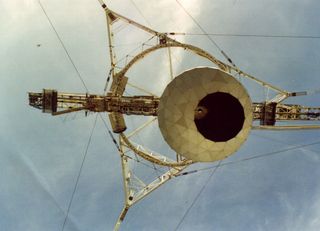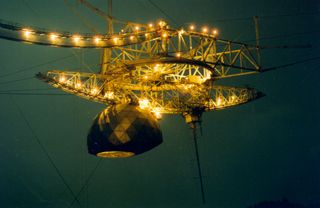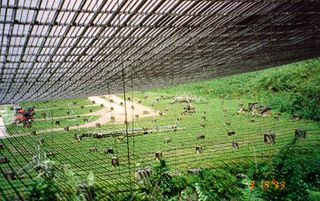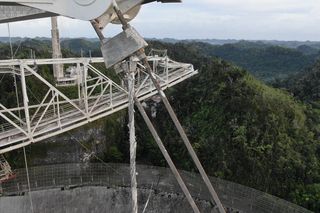Losing Arecibo Observatory would create a hole that can't be filled, scientists say
The telescope is an icon in science, culture and Puerto Rican society.

Editor's note: The National Science Foundation will decommission Arecibo's radio telescope, the agency announced on Nov. 19. Read the full story here.
Arecibo Observatory is facing a mid-life crisis — or something much worse.
In one possible future, the facility's managers work quickly enough to stabilize a massive structure hanging by not-quite-enough-threads and give the venerable science instrument back the rest of its sterling career. In the other, gravity wins, and an iconic observatory — one that owes all its fame to a mistaken calculation — is gone forever.
Right now, not even the finest supercomputer could calculate which future will become reality. Scientists around the world are holding their breath, waiting to see whether the nearly 60-year-old Arecibo Observatory will survive. It's the rare instrument that has not just revolutionized the way experts see our solar system and our universe, but also become a pop-culture icon, featuring in James Bond's "GoldenEye" and the Jodie Foster film "Contact."
Related: Arecibo Observatory may be on the brink of collapse after cable failures
That legacy and the beloved observatory's future alike are at risk after two cables supporting the massive scientific platform above the dish have failed. In August, an auxiliary cable slipped out of its socket; earlier this month one of the main cables unexpectedly snapped. Now, the Puerto Rico facility and its many aficionados are waiting on a decision from the U.S. National Science Foundation (NSF), which owns the site, about how to proceed, informed by analysis conducted by the University of Central Florida, which took over operating the facility in 2018.
"We can prioritize science, we can decide that we want to make sure that Arecibo lasts into the future," Alessondra Springmann told Space.com. She spent nine months living and working at the facility, climbing its many stairs and hiking through the surrounding jungle, befriending the local stray cats and blasting Earth's neighbors with its uniquely powerful radar beam, and she's confident the observatory will make good on a life-saving investment.
Get the Space.com Newsletter
Breaking space news, the latest updates on rocket launches, skywatching events and more!
If Arecibo is given the chance, that is. And this isn't the observatory's first experience with potential doom.

In the 2010s, the NSF repeatedly faced tight budgets that, given the agency's interest in supporting new research facilities, meant it had to make tough choices about its spending. In 2017, after years of considering closing Arecibo outright and scientists expressing their concern about that possibility, the NSF decided to slash its support of the observatory and build a partnership to pick up the slack. That's how the University of Central Florida came to have a hand in the facility.
"I'm sure they [the NSF] would be inclined to say, 'OK, that's it, it's had its day. It's done wonderful work for decades and decades, starting in the late '60s, but now it's time to go on to something else,'" Jill Tarter, a scientist famous for her work on the search for extraterrestrial intelligence (SETI) and the inspiration for the main character in "Contact," told Space.com. "But I think that in making that decision, they really do need to weigh the things that Arecibo can do that other places can't."
The particularly eye-catching item here is planetary radar, a rare capacity even among major radio facilities. Arecibo Observatory is the largest facility in the world that can blast a radar beam at near-Earth objects or even nearby planets, then wait for and analyze the echo as that beam bounces back.
Related: The Arecibo Observatory: Puerto Rico's giant radio telescope in photos

In the case of asteroids, that echo gives scientists the information they need to determine whether the space rock could someday collide with Earth. Other facilities can do it less frequently and with less power, but nothing can match Arecibo, several scientists with ties to the facility emphasized.
Springmann's work focused on planetary radar, and she's sympathetic to the observatory's current plight. "If you're 50 years old and hanging out in 80% humidity all day and going through heat-cooldown cycles, and having 900 tons suspended from you, you would probably have problems too!" she said. Arecibo "really deserves to have a future not because of what it has done in the past, but because of what it can keep doing."
Springmann is just one of the countless scientists whose careers at one stage or another have relied on Arecibo, although she arrived long after the facility cemented its iconic status. Now a doctoral candidate at the University of Arizona, she remembers the sense of potential that pervaded the site throughout her time there.
"It is really just a phenomenal, unique place — there's nothing like it on Earth," Springmann said. "There's very much an 'anything is possible' mentality there because it's designed to be so flexible; you're not necessarily locked in to only doing a handful of things with it."

Want to study the boundary between Earth's atmosphere and space? Want to map the surface of Venus or the distribution of nearby galaxies? Want to find a lost spacecraft or scientists' first exoplanet? Want to listen for gravitational waves rippling across space or send a message out to any aliens listening from afar? Want to determine the risk that a specific near-Earth asteroid will slam into Earth and determine whether it has a moon or two?
Amid the lush greenery of Puerto Rico, Arecibo has done all of those — surely that's enough to outweigh its association with a Bond villain?
Arecibo Observatory owes both its many talents and its iconic status to a massive mistake, it turns out. The facility was first designed to focus on the ionosphere, the region of Earth's atmosphere beginning at 30 miles (50 kilometers) above sea level, that is full of charged particles and represents where Earth meets space.
But a miscalculation in the design phase meant that Arecibo's dish was built about 10 times larger than needed to do such research. At 1,000 feet (305 meters) across, Arecibo Observatory was the largest single radio dish in the world until 2016, when China completed its Five-hundred-meter Aperture Spherical Telescope's (FAST).
And with that one miscalculation — and a few upgrades along the way — Arecibo was given the opportunity to do much, much more than niche atmospheric research.
In addition to its planetary radar work, Arecibo Observatory is also particularly noted for its observations of the fast-spinning neutron stars known as pulsars. Although the strange objects were discovered elsewhere, it was at Arecibo that scientists first identified a binary pulsar, work that won a Nobel Prize, and began the arduous process of trying to measure gravitational waves rippling out from the pair. That work continues today in a partnership with the Green Bank Telescope in West Virginia.

And Arecibo's threefold expertise has had a side effect on the scientists who have spent time at the observatory. "It's really brought a unique cross-section of scientists together," Springmann said. "Usually, planetary people, we don't interact with astronomers much, much less radio astronomers, and so I know all these radio astronomers I wouldn't have met otherwise. I've met aeronomers — I didn't even know aeronomy was a thing before I started there!" (Those are the atmospheric scientists.)
For Tarter, the sense of community was an important part of her time observing at Arecibo. "It was just a really enjoyable time," she said, noting particularly Halloween and Christmas celebrations at the facility. "It's often the case at an observatory, because they're in remote locations, that the staff is kind of like a big family, and that was certainly the atmosphere and what we observed as scientists going there to use the telescope."
But in a trend that is both an opportunity and a loss, fewer and fewer scientists using Arecibo's equipment are doing so in person, within sight of the massive dish. Instead, as with many observatories now, scientists can gather their data remotely, connecting to the facility virtually instead of trekking out through the jungle.
Abel Mendez, an astrobiologist at the University of Puerto Rico, is one of the exceptions, although he doesn't have as far to travel when he does choose to observe in person. He grew up in Puerto Rico and first visited the observatory as a 10-year-old for a personal tour with a scientist.
"He took me everywhere," Mendez told Space.com, "He was able to take me under the dish, which is rare."

The visit made an impression. "I really don't know how this happened, but eventually I returned to use it," Mendez said of the facility. Now, he brings his own students to learn how to use the observatory on-site, a response to his knowledge that he is one of very few Puerto Ricans to actually use the island's most prominent science facility. That's the case even though almost everyone who grows up in Puerto Rico these days tours Arecibo's visitor center, a new addition since his childhood, Mendez said.
This year, one of his students got NASA funding to learn to use Arecibo herself for Mendez's research. But in August, just before she would have begun, a cable holding the massive observing platform suspended above the dish slipped out of its socket and crashed through some of the dish's fragile panels.
Those panels are fairly easy to replace, and that damage alone may have just represented a few months' delay beyond anyone's control, the sort of challenge scientists face all the time. "I thought that when the first cable failed, that probably it would take a few months — probably by December, November it would be fixed," Mendez said.
But then, on Nov. 6, just as the observatory was preparing to address the August damage, a second cable — this time one of the primary supports — unexpectedly snapped, leaving the iconic observatory's fate in serious doubt.

The cables support a massive, 900-ton platform that hangs over the dish, allows scientists to steer the observatory to a specific patch of sky, and holds antennas, control rooms, radar transmitters, and more. The dish may be flashier, and of course it's vital for observations, but it's the platform that holds the scientific heart of Arecibo Observatory.
For Mendez, the uncertainty is uncomfortably similar to what he felt when Hurricane Maria pummeled the island in 2017 as a Category 5 storm, with wind speeds as high as 155 mph (250 kph). As Mendez weathered the storm himself, he worried about the fate of the platform and the heavy dome suspended from it.
"I had in my mind, 'OK, that's broken' — not that the platform went down but probably that structure would be destroyed," he said. And he sat by the phone, waiting for Puerto Rico to recover power and communications services to learn the observatory's fate. But for the most part, the observatory was fine.
"That probably was the most stressful moment, just waiting for any news from the observatory — but it survived," Mendez said.
"Now, it is like that, but I feel like it's more critical right now," he added. "The whole platform falling down? That's the end of it."
Mendez, Tarter, Springmann and countless other scientists are keeping their fingers crossed that the end is not imminent for Arecibo — that the venerable observatory can weather the current storm, as it has so many others, and continue probing the heavens for decades to come.
Email Meghan Bartels at mbartels@space.com or follow her on Twitter @meghanbartels. Follow us on Twitter @Spacedotcom and on Facebook.
Join our Space Forums to keep talking space on the latest missions, night sky and more! And if you have a news tip, correction or comment, let us know at: community@space.com.

Meghan is a senior writer at Space.com and has more than five years' experience as a science journalist based in New York City. She joined Space.com in July 2018, with previous writing published in outlets including Newsweek and Audubon. Meghan earned an MA in science journalism from New York University and a BA in classics from Georgetown University, and in her free time she enjoys reading and visiting museums. Follow her on Twitter at @meghanbartels.
